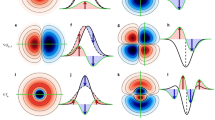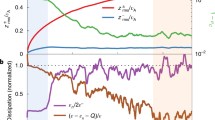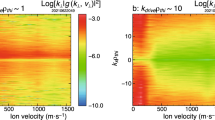Abstract
IN his theory on the origin of the solar system1, Alfvén makes an assumption which is central to the entire theory2. This assumption is that when there is a relative velocity between a plasma and a neutral gas in the presence of a magnetic field, a strong ionization process will set in when the relative velocity reaches a critical value Ucrit such that  where mg and Vi are the mass and ionization potential of the gas atom. Using this assumption, Alfvén has been able to predict fairly accurately the mass distribution of the planets and satellites in the solar system. A study of the ionization mechanism leads to some difficulties, however; first, the threshold energy for ionization in a collision between a gas atom and an ion of the same gas is 2 eVi (ref. 3) and, second, the ionization cross-section of ions is very small compared with that of electrons, except at very high energies. It has been suggested4 that the ionization must be caused by the electrons and that energy is transferred from the ions to the electrons by some kind of space charge mechanism which is not discussed in detail. The purpose of this communication is to point out three simple ionization mechanisms which lend support to the critical velocity hypothesis.
where mg and Vi are the mass and ionization potential of the gas atom. Using this assumption, Alfvén has been able to predict fairly accurately the mass distribution of the planets and satellites in the solar system. A study of the ionization mechanism leads to some difficulties, however; first, the threshold energy for ionization in a collision between a gas atom and an ion of the same gas is 2 eVi (ref. 3) and, second, the ionization cross-section of ions is very small compared with that of electrons, except at very high energies. It has been suggested4 that the ionization must be caused by the electrons and that energy is transferred from the ions to the electrons by some kind of space charge mechanism which is not discussed in detail. The purpose of this communication is to point out three simple ionization mechanisms which lend support to the critical velocity hypothesis.
This is a preview of subscription content, access via your institution
Access options
Subscribe to this journal
Receive 51 print issues and online access
$199.00 per year
only $3.90 per issue
Buy this article
- Purchase on Springer Link
- Instant access to full article PDF
Prices may be subject to local taxes which are calculated during checkout
Similar content being viewed by others
References
Alfvén, H., in On the Origin of the Solar System (Oxford University Press, 1954).
Alfvén, H., and Wilcox, J. M., Astrophys. J., 136, 1016 (1962).
von Engel, A., in Ionised Gases, 68 (Oxford University Press, 1965).
Alfvén, H., Rev. Mod. Phys., 32, 710 (1960).
Sherman, J. C., thesis, Univ. Oxford (1967).
Blevin, H. A., and Haydon, S. C., Austral. J. Phys., 11, 18 (1958).
Cramer, W. H., and Simons, J. H., J. Chem. Phys., 26, 1272 (1957).
McDaniel, E. W., in Collision Phenomena in Ionised Gases, 146 (Wiley, 1964).
Rostagni, A., Nuovo Cim., 15/2, 117 (1938); ibid., 11, 34, 39 (1934); von Engel, A., in Ionised Gases, 70 (Oxford University Press, 1965).
Hayden, H. C., and Utterback, N. G., Phys. Rev., A, 135, 1575 (1964).
Fahleson, U. V., Phys. Fluids, 4, 123 (1961).
Angerth, B., Block, L., Fahleson, U. V., and Soop, K., Nucl. Fusion, suppl., Pt. 1, 39 (1962).
Drobyshevskii, É. M., Soviet Phys.: Tech. Phys., 8, 903 (1964).
Author information
Authors and Affiliations
Rights and permissions
About this article
Cite this article
SHERMAN, J. Alfvén's Critical Velocity Hypothesis. Nature 217, 341–342 (1968). https://doi.org/10.1038/217341a0
Received:
Issue Date:
DOI: https://doi.org/10.1038/217341a0
Comments
By submitting a comment you agree to abide by our Terms and Community Guidelines. If you find something abusive or that does not comply with our terms or guidelines please flag it as inappropriate.



